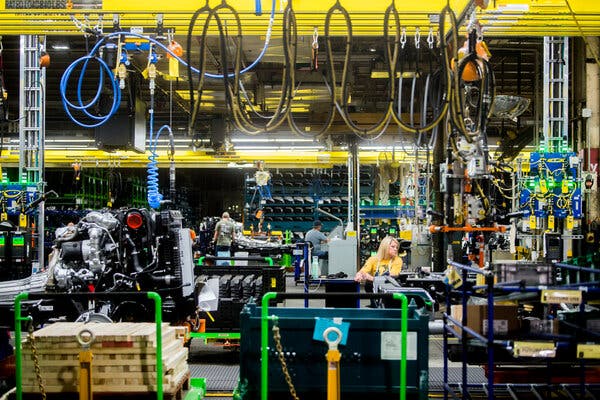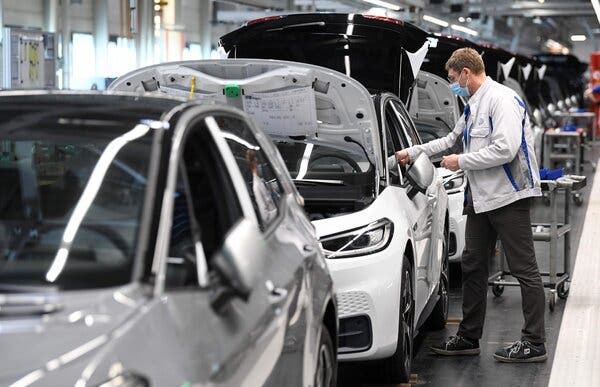Here’s what you need to know:
-
U.S. stocks fell on Tuesday, as the sudden pullback in technology stocks continued into a third day. The S&P 500 slid about 2 percent in early trading, while the tech-heavy Nasdaq composite was down more than 2 percent.
-
Including the early decline Tuesday, the S&P 500 is down by about 6 percent since last Wednesday’s close, and the Nasdaq composite by about 9 percent.
-
Tesla was among the biggest losers on Tuesday, falling nearly 15 percent after the company was left off the list of stocks added to the S&P 500 index on Friday. The heavyweight tech stocks that have led the rally since spring were all lower on Tuesday, including Apple, Amazon and Google parent company Alphabet.
-
SoftBank’s role in the rise — and fall — of tech stocks remains a major talking point among investors. The Japanese conglomerate had made outsized bets on stock options, pushing the dealers who sold them to buy shares to hedge their exposure. This strategy can also amplify moves in the other direction, as it has in recent days. SoftBank shareholders in Japan sold the company’s stock for a second straight day on Tuesday, appearing uneasy with the company’s risky bets.
-
Stocks were also depressed by concerns over worsening U.S.-China trade relations and uncertainty over the pandemic’s impact on the airline industry.
-
European stocks were lower as well. The benchmark Euro Stoxx 600 index was nearly 2 percent lower, while France’s CAC 40 fell by more than 2 percent. In Asia, stock indexes finished the day higher, with Japan’s Nikkei gaining 0.8 percent and China’s Shanghai Composite adding 0.7 percent.
-
Oil futures also fell, with Brent crude down more than 4 percent and West Texas Intermediate slumping more than 6 percent. Investor seeking the safety of long-term bonds pushed the price of U.S. 10-year Treasury notes higher. Gold was about 1 percent lower, at $1,912 an ounce.
-
Remarks by President Trump during a campaign-style news conference on Monday stirred concerns about the growing separation between the United States and Chinese economies. “We lose billions of dollars, and if we didn’t do business with them we wouldn’t lose billions of dollars. It’s called decoupling, so you’ll start thinking about it,” Mr. Trump said, according to Reuters.
-
The coronavirus pandemic continues to take a big toll on the travel business. The Britain-based discount airline easyJet, which expanded its flights about a month ago, said it would reverse course and reduce its flying schedule. The airline said changing government restrictions on travel, caused by spikes in virus outbreaks, had created confusion among potential passengers. Its stock fell more that 7 percent.
Barely a week ago Tesla shares were flying higher than ever. The electric-car maker had just completed a five-for-one split of its shares, which closed at a split-adjusted record price. And after a fourth consecutive quarter of profitability, it seemed on the brink of addition to the S&P 500, which would create new demand for its shares from index funds.
Now things don’t look as rosy. Tesla’s shares were trading around $350 on Tuesday, down 16 percent on the day and about 30 percent from their recent peak.
The tumble started after company announced in a regulatory filing on Sept. 1 that it would raise up to $5 billion in capital by selling new shares “from time to time” at market prices. That figure represented barely 1 percent of Tesla’s market capitalization, but shares fell nearly 5 percent.
Then, on Friday, Tesla was bypassed when the S&P 500 components were shuffled. And sentiment may have been influenced by a broader swoon in technology stocks that has continued into this week.
Still, on a split-adjusted basis, the decline leaves Tesla shares roughly where they were three weeks ago, and at four times their price at the start of the year. The company’s market capitalization is three times the combined value of Ford Motor, General Motors and Fiat Chrysler.
Oil prices tumbled on Tuesday, as the recovery from last spring’s collapse gave way to a wave of concerns that the market was not as strong as expected.
West Texas Intermediate, the American benchmark, fell around 8.75 percent on Tuesday to $36.29 a barrel, while Brent crude, the international standard, slipped almost 6 percent to $39.53.
“People came back from the holiday and said that this whole summer of bullishness is over,” said Roger Diwan, vice president for energy at IHS Markit, a research firm. Instead, Mr. Diwan said, market participants are responding to signs of weakening demand, growing supplies of oil, and what promises to be a nerve-jangling presidential election campaign in the United States.
Oil prices have rallied sharply from their April lows, when some futures prices fell into negative territory, and held steady during the summer. Now, when traders look ahead, prices look too high. With the summer driving season over, the outlook for demand is weak over the next few months.
At the same time, the Organization of the Petroleum Exporting Countries, which slashed oil production in May, is now adding output, joining producers in the United States, who are also gradually pumping more crude.
“Prices have diverged from fundamentals for awhile, “ said Amrita Sen, head of oil analysis at Energy Aspects, a market research firm.
The coronavirus pandemic, which has slammed demand, is clearly far from over, with cases rising in several countries including Britain, France and Spain. And there are signs that Chinese buyers who have stocked up on crude at what seemed low prices may be reaching their limit.

Boeing said Tuesday that it expects deliveries of its 787 Dreamliner to be delayed in the near-term as it conducts thorough inspections of the plane amid mounting quality-control concerns.
The company has already identified production problems with some Dreamliners, wide-body jets that are capable of carrying hundreds of people long distances. The company said last month that it grounded eight of the planes for inspection and repair after finding that it had fallen short of its own standards in two ways during manufacturing of the plane’s body. On Tuesday, Boeing said it identified another problem related to the plane’s horizontal stabilizer, but added that the issue did not pose an immediate safety risk.
The Federal Aviation Administration is also investigating the company for manufacturing flaws related to the plane.
“The agency continues to engage with Boeing,” the F.A.A. said in a statement. “It is too early to speculate about the nature or extent of any proposed airworthiness directives that might arise from the agency’s investigation.”
The agency is considering whether to require deeper inspections of most of the approximately 1,000 Dreamliners delivered since 2011, The Wall Street Journal reported on Monday, citing internal documents.
The Dreamliner is a star of Boeing’s fleet, a relatively fuel-efficient twin-aisle airplane suited to carry hundreds of passengers on long, international flights. Japan’s All Nippon Airways owns 73 of the planes, more than any other airline. United Airlines is second, with 55 planes; followed by Japan Airlines, with 49; and American Airlines, with 44.
The Dreamliner problems come as Boeing prepares for the return of the 737 Max, which was grounded worldwide more than a year ago after 346 people were killed in two fatal accidents.
On Tuesday, Boeing also said that it booked eight new orders for planes in August, while 20 others were canceled. The company also removed 84 planes from its backlog as part of an accounting adjustment that weighs declining confidence in orders.
So far this year, the company has lost a net 932 orders after accounting for new orders, cancellations and the accounting adjustment. It has a backlog of 4,387 orders. Shares of Boeing fell nearly 5 percent on Tuesday.

General Motors said Tuesday that it would take a $2 billion equity stake in Nikola Corporation, a start-up aiming to make electric and hydrogen-powered trucks that has become a favorite of investors.
G.M. said it would build pickup trucks for Nikola and provide battery pack technology in exchange for an 11 percent stake in Nikola. In a statement Nikola said it expects the partnership will save more than $4 billion in battery and powertrain costs over 10 years, while G.M. said it expects to receive more than $4 billion in benefits stemming from the equity value of its stake, and supplier and manufacturing contacts with Nikola.
“Our backgrounds are different but we share the goal of putting as many E.V.s in the hands of our customers as possible,” G.M.’s chief executive, Mary T. Barra, said in a conference call, referring to electric vehicles.
The truck will use modular battery packs that G.M. has designed and plans to produce in a new factory that is under construction in Ohio. G.M. did not say where it will assembly trucks for Nikola.
“This will allow Nikola to achieve things it could never do alone,” Nikola’s founder and executive chairman, Trevor Milton, said. “Being able to avoid building our own factory has saved Nikola billions of dollars.”
Nikola also intends to offer a version of the Badger truck powered by hydrogen fuel cells supplied by G.M. “This allows us to build the Badger on fuel cells that are fully validated,” Mr. Milton said.
Nikola has not sold any trucks yet but investors have snapped up the company’s shares, betting that it will be one of the winners in a rapid transition to electric vehicles. The stock market values the company at nearly $19 billion. On Tuesday its stock was up about 40 percent, to nearly $50. G.M. stock gained 7 percent to more than $32.
G.M. has been working on some two dozen electric cars and trucks of its own. Those vehicles will use the company’s “Ultium” battery packs. The company has also formed a partnership to provide battery packs to and develop electric vehicles with Honda Motor.
Nikola’s Badger truck may arrive in a crowded market. G.M., Ford Motor, Tesla and at least two other start-ups — Rivian and Lordstown Motors — are all working on electric pickup trucks.

Alaska chopped resources for public broadcasting. New York City gutted a nascent composting program that could have kept tons of food waste out of landfills. New Jersey postponed property-tax relief payments.
Across the nation, states and cities have made an array of fiscal maneuvers to stay solvent and are planning more in case Congress can’t agree on a fiscal relief package after the August recess.
House Democrats included nearly $1 trillion in state and local aid in the relief bill they passed in May, but the Senate majority leader, Mitch McConnell of Kentucky, has said he doesn’t want to hand out a “blank check” to pay for what he considers fiscal mismanagement, including the enormous public-pension obligations some states have accrued. There has been little movement in that stalemate lately.
Economists warn that further state spending reductions could prolong the downturn by shaking the confidence of residents, whose day-to-day lives depend heavily on state and local services.
“People look to government as their backstop when things are completely falling apart,” said Mark Zandi, chief economist at Moody’s Analytics. “If they feel like there’s no support there, they lose faith and they run for the bunker and pull back on everything.”
State and local governments administer most of America’s programs for education, public safety, health care and unemployment insurance. They also provide a wide variety of smaller services, such as outdoor recreational facilities or highway rest stops, that improve the quality of life. The costs of many of these programs have spiraled because of the pandemic, which has at the same time caused an economic slump that has driven down tax revenues.
Collectively, state governments will have budget shortfalls of $312 billion through the summer of 2022, according to a review by Moody’s Analytics. When local governments are factored in, the shortfall rises to $500 billion. That estimate assumes the pandemic doesn’t get worse.

The rate at which workers suffered violations of minimum-wage law increased almost in lock step with the unemployment rate during the last recession, according to a paper released Thursday by the Washington Center for Equitable Growth, a liberal think tank. On average, the workers on the receiving end of these violations lost about one-fifth of their hourly wage.
The paper’s numbers show that more than 20 percent of low-wage workers were probably paid less than what the law requires in April, when the unemployment rate peaked, up from just over 10 percent before the pandemic.
There are two key reasons, beyond the obvious problem that employers are stretched thin during a recession. First, workers have fewer job options when the economy is weak, making it harder to stand up to employers that shortchange them.
In addition, labor regulators often have fewer resources to devote to enforcement during a recession, as cities and states cut their budgets.
The lack of effective regulation reverberates through entire industries, the study’s authors write: Unchecked wage theft allows unscrupulous employers to undercut their law-abiding competitors and puts pressure on those competitors to shortchange their workers as well.
Restaurant suppliers like bakeries scaled back workers’ hours and laid off many of them during the pandemic, driving workers who had made the minimum wage or more into less stable, lower-paying gigs, said Gabriel Morales, the program director for Brandworkers, a group that organizes workers in the specialty food-making industry.
“People are being pushed into even more exploitative sectors of the economy,” Mr. Morales said.

Elon Musk had faint praise for Volkswagen’s new ID.3 electric car after a test drive last week. “For a non-sporty car it’s pretty good,” Mr. Musk, the chief executive of Tesla, said in a video of the drive posted Monday by Herbert Diess, the chief executive of Volkswagen.
During a trip to Germany Mr. Musk took a quick spin in the ID.3 with Mr. Diess riding shotgun. The car, which is being shipped to dealers in Europe, is the German carmaker’s bid to make electric cars affordable to the masses and meet the threat posed by Tesla, which has been taking market share in Europe and is building a factory near Berlin.
In the video shot on a rainy airport tarmac, Mr. Musk asks about the size of the ID.3’s battery and whether it has autonomous driving features. There is a note of skepticism in his voice.
Off-camera, Mr. Musk criticized the ID.3’s power at high speed, according to Mr. Diess, who replied: “Yes, we are on the runway — but no need for takeoff — it’s not a sports car.” If Mr. Musk wants performance he should drive the electric Porsche Taycan, Mr. Diess added.
Mr. Diess quashed any speculation that the two men, who have discussed working together in the past, were hatching some kind of deal. “Just to be clear,” Mr. Diess wrote on LinkedIn, “we just drove the ID.3 and had a chat — there is no deal/cooperation in the making.”

Used cars are usually overlooked in the fanfare accorded cutting-edge electric cars and gussied-up pickup trucks. Now they are suddenly the industry’s hottest commodity.
Consumers are snapping up used vehicles as second or third cars so they can avoid trains, buses or Ubers during the coronavirus pandemic. Others are buying used rather than new to save money in an uncertain economy, not knowing when they or their spouse might lose a job. Demand for older cars has also been fed by a roughly two-month halt in production of new cars this spring.
Across the country, the prices of used cars have shot up. The increase defies the conventional wisdom that cars are depreciating assets that lose a big chunk of their value the moment they leave the dealership. In July alone, the average value of used cars jumped more than 16 percent, according to Edmunds.com.
In June, the most recent month for which data is available, franchised car dealers sold 1.2 million used cars and trucks, according to Edmunds, up 22 percent from a year earlier. It was the highest monthly total since at least 2007.
“Used cars are supposed to depreciate, but I’d look up the book value of a car on the lot and see it was higher than at the beginning of the month,” said Adam Silverleib, president of Silko Honda in Raynham, Mass. “I’ve never seen that before.”
🗣 In a relatively quiet, holiday-shortened week, companies reporting quarterly earnings include Lululemon and Slack today; American Eagle Outfitters on Wednesday; Chewy, Oracle and Peloton on Thursday; and Kroger on Friday.
🇨🇦🇪🇺 The Bank of Canada and European Central Bank hold policy meetings on Wednesday and Thursday, respectively. No changes to interest rates are expected, but analysts will be poring over the post-meeting comments and statements for clues on the course of economic recovery.
📈 Economists will focus on U.S. inflation data, with producer prices out on Thursday and consumer prices on Friday. The Fed’s recent rethink of how it balances inflation with job growth will put extra attention on these monthly stats.

Ability to work from home
National Bureau of Economic Research

Ability to work from home

Ability to work from home
When companies dispatched office staff to work remotely from home, cut business trips and canceled business lunches, they also eliminated the jobs cleaning their offices and hotel rooms, driving them around town and serving them meals.
For this army of service workers across urban America, the pandemic risks becoming more than a short-term economic shock. If white-collar America doesn’t return to the office, service workers will be left with nobody to serve.
The worry is particularly acute in cities, which for decades have sustained tens of millions of jobs for workers without a college education. Now remote work is adding to other pressures that have stunted opportunities. The collapse of retailers like J.C. Penney and Neiman Marcus has wiped out many low-wage jobs. The implosion of tourism in cities like New York and San Francisco will end many more.
Fear is budding that even when the pandemic has passed, the economy may not provide the jobs it once did.
“Some law firms are finding that it is more productive for their lawyers to stay at home,” said Kristinia Bellamy, a janitor who was laid off from her job cleaning offices at a high-rise housing legal firms and other white-collar businesses in Midtown Manhattan. “This might be the beginning of the end for these commercial office buildings.”
Consider Nike’s decision in the spring to allow most employees at its headquarters in the Portland area to work remotely. Aramark, which runs the cafeteria and catering at Nike, furloughed many of its workers. With no need for full services anticipated “for an undefined period,” Aramark says, 378 employees — waiters, cooks, cashiers and others — now face permanent layoff on Sept. 25.
After tech companies told employees to work from home because of the coronavirus pandemic, they began offering new benefits like extra time off to help workers take care of their children.
It wasn’t long before employees without children started to ask: What about us?
Daisuke Wakabayashi and Sheera Frenkel detail the friction, which is more pronounced at some technology companies, where workers tend to be younger and have come to expect generous perks and benefits in exchange for letting their jobs take over their lives.
-
At a recent companywide meeting, Facebook employees repeatedly argued that work policies created in response to Covid-19 “have primarily benefited parents.”
-
At Twitter, a fight erupted on an internal message board after a worker who didn’t have children at home accused another employee, who was taking a leave to care for a child, of not pulling his weight.
-
When Salesforce announced that it was offering parents six weeks of paid time off, most employees applauded. But one Salesforce manager, who is not permitted to talk publicly about internal matters and therefore asked not to be identified, said two childless employees, reflecting a sentiment voiced at several companies, complained that the policy seemed to put parents’ needs ahead of theirs.
Tech companies were among the first to ask employees to work from home at the start of the pandemic and to offer generous leave and additional time off once it became apparent that children would remain home from school as well.
Some employees without children say that they feel underappreciated, and that they are being asked to shoulder a heavier workload. And parents are frustrated that their childless co-workers don’t understand how hard it is to balance work and child care, especially when day care centers are closed and they are trying to help their children learn at home.
















